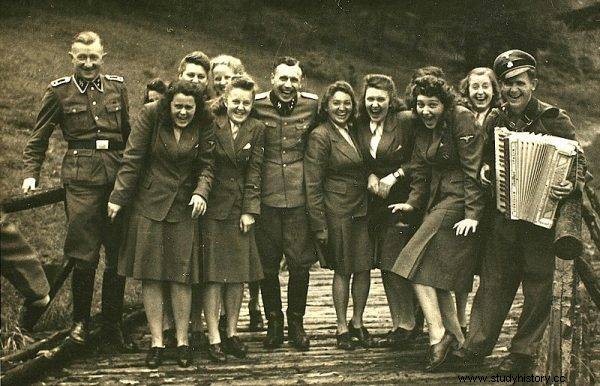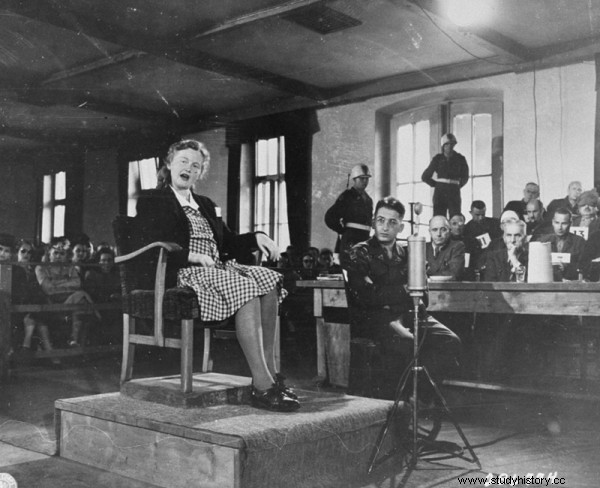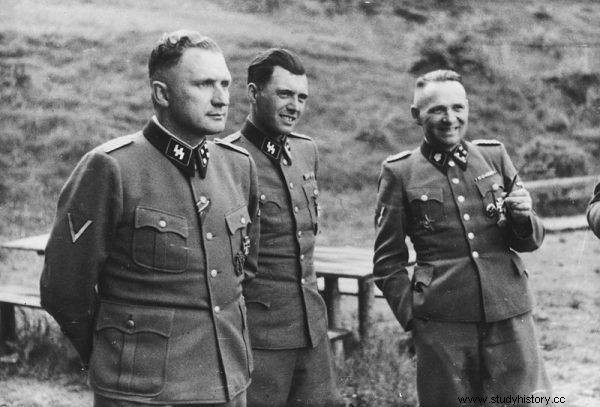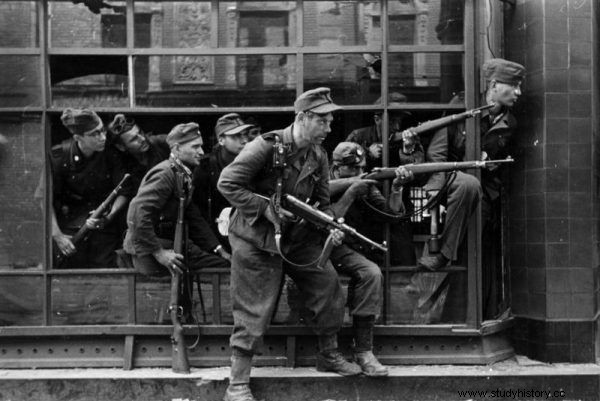Psychopaths and murderers reached the highest levels of careers in the security and order apparatus of the Third Reich. If they were cruel enough, they would become, for example, concentration camp commanders. If there were to be any gloomy ranking of the worst type of creatures, these three would surely go to it:Amon Göth, Ilse Koch and Josef Mengele. What made these seemingly normal people turn into beasts at Hitler's service?
It is believed that five percent of the human population has a tendency to display sadistic behavior. Fortunately, it remains dormant in most cases. However, sometimes favorable circumstances lead to the emergence of this feature. War is one of them.
The state apparatus of the Third Reich found this inclination useful and for many years tolerated and even rewarded various kinds of psychopathic degenerates who showed above-average cruelty towards "enemies of the state". In the SS centers preparing the guards to work in the camps, a training system was introduced under which they underwent a hardening process that was to make them immune to the compassion that the suffering of the prisoners under their care could cause. The aim of these training sessions was to awaken the feeling of hatred, power and oppression, and to eradicate any reflexes of pity.
SS-Obergruppenführer Theodor Eicke, the creator of the German concentration camp system and the initiator of the creation of the SS-Totenkopfverbände (skull head troops), told candidates for camp guards and supervisors that their training was intended to "make them hard as steel and to subhumans did not consider us soft ” .
The vast majority of the guards serving in the camps had blood on their hands and dozens of criminal acts on their account. There were individuals who endeavored to treat prisoners more leniently, fairly, and even to help them, but such people were quickly "brought to order."

The vast majority of guards serving in the camps had blood on their hands and dozens of criminal acts on their account.
Average camp officers believed that they were doing the same job as any other, and the brutal treatment of prisoners was only a means to successfully complete the task entrusted to them. Unfortunately, the camps also revealed depraved individuals whose passion for inflicting pain and suffering and the will to murder exceeded anything we can imagine. They were cruel beyond measure.
Their biographies were thoroughly analyzed by Jesus Hernandes, a Spanish historian and journalist specializing in the subject of the Second World War. In his book Kaci z SS. Nazi beasts ”told about the lives of three men and one woman who, thanks to the power that belonging to the SS gave them, were able to vent their wildest instincts. Were these cruel concentration camp torturers just "born" sadists who loved to inflict pain and suffering and to kill? Or maybe it was only the victorious war, the German conquest of a large part of Europe and the feeling of impunity among the functionaries of the Third Reich that made them become beasts?
Amon Göth
An authentic psychopath, cherishing the pleasure of inflicting pain on people under his power, was Amon Göth, the commandant of the concentration camp in Płaszów. In 1942, he successfully carried out the operation "Reinhardt", the aim of which was Judenumsiedlung, that is, "resettlement of Jews". In fact, was not about resettlement, but about the planned extermination to which nearly two million people were subjected.
Göth again proved himself by taking part in the liquidation of the great ghetto in Lublin, thanks to which he deserved a promotion and in early 1943 he became the commander of the new concentration camp in Płaszów and the head of the ghetto liquidation operation in Krakow. Here his murderous tendencies were fully revealed. It quickly gained the ominous nickname "Kat Płaszowa".
When Göth was still living in a house near the former synagogue, he used to go down the stairs each morning after breakfast wearing his shirt, riding pants and officers freshly cleaned by the orderly . He would go out without a shirt in nice weather.

The text is based on the book by Jesus Hernandez "Nazistowskie beasts. Kaci z SS ”, which has just been released by the Bellona publishing house.
He appeared with binoculars in one hand and a sniper rifle in the other. Cigarette in his mouth, he calmly watched through the optical sight of prisoners walking a few hundred meters from the house, pushing heavy wagons loaded with limestone. The one who, according to Göth, was not working hard enough was shot immediately . After a fatal shot, the guards usually limited themselves to dragging the dead man away and abandoning him at the edge of the road.
He once released his two dogs, Ralf and Rolf, on an inmate named Olmes. The dogs started eating him alive until Göth ended his life with a shot…
All Płaszów prisoners were sure that the life of whom Göth considered redundant had absolutely no meaning. Without showing the slightest emotion, he was able to send any prisoner to their death, whether with a reason or not.
Hernandez in his book "The Executioners of the SS" writes that Göth, who was a fierce anti-Semite, had the bizarre habit of "celebrating" important holidays in the Hebrew calendar by executing Jewish prisoners . On September 30, 1943, on the occasion of Rosh Hashanah, the Jewish New Year, he had all the inmates positioned on the roll-call square, then selected 200 of them and ordered them to be killed.
It is estimated that on his order about 8,000 prisoners were killed in Płaszów, and Göth killed 500 of them personally. He was also responsible for the deaths of several thousand Jews from Lublin, Kraków and Tarnów as well as smaller ghettos and sub-camps. After the trial in Krakow in 1946, the Supreme National Tribunal sentenced Göth to death by hanging. The sentence was carried out on September 13, 1946.
Ilse Koch
Another unsatisfied sadist and psychopathic torturer who was created by the terrifying world of Nazi concentration camps was SS-Aufseherin Ilse Koch, known by the nickname "Buchenwald female dog". Ilse was the wife of Karl Koch, commandant of the Buchenwald concentration camp. She lived with him and the children in the camp from 1937 to 1941.
In the camp, her sadistic needs were met. Ilse - at the urging of her husband - began to torture prisoners and women prisoners, she also forced them to rapes each other against each other . She considered the offense justifying the beating ... to raise her eyes and look at her. The inmates quickly understood this, and in the presence of Ilse Koch, they bowed their heads and stared at the ground. Anyone who forgot himself and looked at an SS woman was beaten to the point of loss of consciousness.
Ilse Koch selected those with interesting tattoos from among the prisoners and ordered them to be made into everyday articles of their skin such as gloves, handbags, book covers and lamp shades. For these reasons, she had a second nickname:Ilsa-Abażur.

SS-Aufseherin Ilse Koch, known under the nickname "Buchenwald female dog"
After the war, the woman defended herself so deftly in court that most of the evidence against her was refuted. In her case testified, inter alia, a Czech prisoner who saw Ilse Koch order another inmate to take off his shirt so that she could examine his tattoos and wrote down his camp number. During the night, the man disappeared. Another inmate, Richard Gryc, remembered Ilse saying to someone, "You have a nice tattoo" - and that person disappeared that same day. Other survivors told of how she rode a horse between them, beating them with all her might with her whip on the back. One of the people standing "too close" she kicked in the face, causing him to lose his teeth.
The prisoners also remembered that Mrs. Koch wandered around in provocative costumes near them and noted the number of the one who dared to look at her . Later, he was severely punished - usually with beatings and torture, and even death. When an inattentive man made a carelessness and spoke to her, he was summoned to appear at the front gate and was never heard of again.
During the trial in which she appeared as the accused, Ilse Koch said, “ I was the housewife and mother to my children. I had nothing to do with the concentration camps and my husband never told me about it, and I have never seen or heard of the items discussed here. ”
In 1947, she was the only woman indicted in the Buchenwald trial for crimes against humanity and sentenced to life imprisonment. Since she became pregnant while in custody (she never disclosed the child's father's name), she was commuted to four years' imprisonment. It was not until 1951 that she received the original sentence in another trial. For many years she sought pardon, and when it failed, she hanged herself in a prison cell.
Josef Mengele
Another officer of the German security apparatus known for his sadistic tendencies was the doctor of medicine and anthropology, SS-Hauptsturmführer Josef Mengele, known as the Angel of Death. This figure is quite well known in Poland, and his crimes have been widely described in the press and in the literature. Several books have been published about him in recent years, so let us just remind you that Mengele was a doctor in Auschwitz who carried out all kinds of inhuman experiments on prisoners . From the very beginning, he participated in the selections and extermination of Jews and Roma arriving at the camp. Hernandez writes:
When the trains came in, Mengele ran up the ramp shouting, "Gemini! Twins!". He hoped thanks to them to discover the mystery of multiple pregnancies and to be able to induce them so that the Nazi regime could achieve an increase in the number of births of Aryan children.
He found the twins very useful in the experiments as he experimented with one pair and left the other as a control:both were killed and a simultaneous dissection was performed to evaluate the results . He also killed twins simultaneously without conducting any experiments before, only to seize the opportunity to perform a simultaneous autopsy, a possibility that is hard to come across under normal circumstances.

Josef Mengele (center) was called the Angel of Death
He was cruel and caring at the same time. He gave the children candies and chocolate, for which they adored him and lovingly referred to him as "Uncle Pepi", not suspecting what his intentions were towards them. Among the experiments that "Uncle Pepi" carried out were amputation and reattachment of limbs, injecting germs of various diseases, inflicting wounds and infecting them . Dozens of children were injected with eye dyes to find out if they could be turned into Aryan blue irises. This caused infections and often blindness.
Mengele was also trying to find the most effective method of preventing races considered by the Nazis as inferior from reproducing. So he experimented with women to determine the amount of irradiation needed to sterilize them by exposing them to X-rays and then removing their ovaries to test the result.
The sadistic doctor from KL Auschwitz was an eminently intelligent entity. He had an analytical mind, he was great at calculating and making predictions. In April 1945, in the last days of the war, he joined a Wehrmacht unit, changed the SS uniform to an ordinary soldier's uniform and was taken prisoner in it. He already knew that ordinary soldiers were better treated and less guarded than those of the SS. Mengele did not have a blood type tattoo characteristic of the members of this formation, so he managed to avoid insightful interrogations and in September 1945 he was released from a POW camp.
In 1949, thanks to the help of the Church, he left for South America, where he hid for many years, first in Argentina, then in Paraguay, and finally in Brazil. Israeli intelligence, Mossad, was on its trail, but the Angel of Death managed to escape justice. In 1979, while swimming in the ocean, he suffered a stroke and drowned.
Oskar Dirlewanger
The fourth war criminal described by Hernandez is SS-Oberführer Oskar Dirlewanger. This sadist was not a camp officer, but the commander of a combat unit. Under his command were criminals released from prisons, who were to blot out their guilt in the fight. Dirlewanger's unit conducted operations against partisans in occupied Poland, Belarus and Slovakia. In Poland, Dirlewanger is known primarily as the "Executioner of the Warsaw Uprising" .

Soldiers of the Dirlewanger branch in Warsaw
From August 5, 1944, he commanded a unit of the SS-Sonderregiment Dirlewanger, which numbered about 2,000 people. to Wola. It is estimated that on the 500-meter section of ul. Wolska the "Dirlewanger soldiers" murdered 12,500 people within a few days . In total, his unit killed about 30,000 Poles during the Uprising, mainly civilians in Warsaw, but also many wounded and captured insurgents. In the fall of 1944, his unit also suppressed a national uprising in Slovakia.
After the war, on June 1, 1945, Dirlewanger was arrested in Altshausen in the French zone of occupation. He died on June 7 under mysterious circumstances in prison. There are many indications that he was beaten to death by Polish prison guards recruited from among former concentration camp prisoners.
It is worth noting, however, that in the post-war years there were rumors that he survived and was a military adviser in Egypt in the 1960s. Hernandez considers this version to be questionable, but points out that there is no 100% certainty as to the post-war fate of this criminal, and the French archives will be opened only 100 years after the event - i.e. in 2045.
Bibliography:
- J. Hernandez, Kaci of the SS. Nazi Beasts, Bellona, 2021
